How to save presentations in PowerPoint 2016
Whenever you create a new presentation in PowerPoint, you'll need to know how to save it for later access and editing. As with previous versions of PowerPoint, you can save files to your computer. If you like, you can also save the file to a cloud service like OneDrive. You can even export and share presentations directly from PowerPoint.
How to save presentations in PowerPoint 2016
- Save and Save As
- About OneDrive
- How to save the presentation
- Use Save As to create a copy
- How to change the default save location
- Use the AutoRecover feature
- How to use AutoRecover
- Export presentation
- How to export the presentation
- Share the presentation
- How to share the presentation
- Practice!
Save and Save As
PowerPoint provides two ways to save files: Save and Save As. These options work in similar ways, but with a few important differences.
- Save: When you create or edit a presentation, you will use the Save command to save your changes. You will use this command most of the time. When you save the file, you just need to select the file name and location to save the first time. Then, simply click the Save command to save the same name and location.
- Save As: You will use this command to create a copy of the presentation while keeping the original. When you use Save As, you need to choose a different name and / or location for the copied version.
About OneDrive
Most features in Microsoft Office, including PowerPoint, aim to save and share documents online. This is done with OneDrive, this is the online storage space for your documents and files. If you want to use OneDrive, make sure you're signed in to PowerPoint with your Microsoft account.
How to save the presentation
It is important to save your presentation whenever you start a new project or make changes to the current project. Saving your ongoing work can prevent your document from being lost when a problem occurs. You will also need to pay attention to where you save the presentation to easily find it later.
1. Locate and select the Save command on the Quick Access Toolbar.
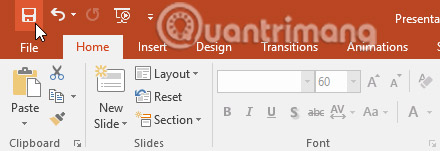
2. If you are saving the file for the first time, the Save As feature will appear in the Backstage view .
3. After that, you will need to choose where to save the file and name it. Click Browse to select the location on your computer. Alternatively, you can click OneDrive to save the file to your OneDrive.

4. The Save As dialog box will appear. Select the location where you want to save the presentation.
5. Enter the file name for the presentation, then click Save.

6. Presentation will be saved. You can click the Save command again to save your changes when you modify the presentation.
You can also access the Save command by pressing Ctrl + S on the keyboard.
Use Save As to create a copy
If you want to save another version of the presentation while keeping the original, you can create a copy. For example, if you have a file named Client Presentation, you can save the file as Client Presentation 2 so you can edit the new file and still reference the original version.
To do this, you will click the Save As command in the Backstage view . Just like when you save the file for the first time, you need to choose the location to save the file and name the new file.

How to change the default save location
If you don't want to use OneDrive, you might be disappointed when OneDrive is selected as the default location when saving files. If you find this inconvenient, you can change the default save location to This PC is selected by default.
1. Click the File tab to access the Backstage view mode .
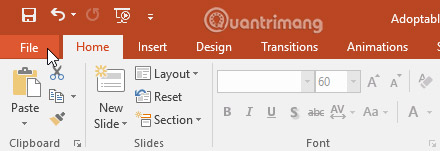
2. Click Options.

3. The PowerPoint Options dialog box will appear. Select Save, check the box next to Save to Computer by default, then click OK. The default save location will be changed.

Use the AutoRecover feature
PowerPoint automatically saves your presentation to a temporary folder while you are working on them. If you forget to save your changes or if PowerPoint has a problem, you can restore the file with the AutoRecover feature .
How to use AutoRecover
1. Open PowerPoint. If you find automatically saved versions of a file, the Document Recovery panel will appear.
2. Click here to open an existing file. The presentation will be restored.
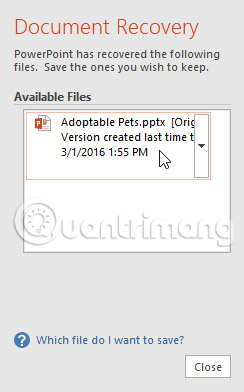
By default, PowerPoint automatically saves every 10 minutes. If you are editing the presentation in less than 10 minutes, PowerPoint may not create an automatically saved version.
If you don't see the file you need, you can browse all files saved automatically from the Backstage view. Just select the File tab , click Manage Presentation, then select Recover Unsaved Presentations.

Export presentation
By default, PowerPoint presentations are saved in the .pptx file format. However, there may be times when you need to use another file type, such as PDF or PowerPoint 97-2003. It's easy to export your presentation from PowerPoint in many different file formats.
- PDF: Save presentations as PDF documents instead of PowerPoint files
- Video: Save the presentation as a video
- Package for CD : Save the presentation in a folder with Microsoft PowerPoint Viewer, a special slideshow that users can download
- Handouts: Print a handout for your slides.
- Other file types: Save on other file types, including PNG and PowerPoint 97-2003
How to export the presentation
In the example in this article, we will save the presentation as a PowerPoint 97-2003 file .
1. Click the File tab to access the Backstage view mode .
2. Click Export, then select the desired option. In this example, we will select Change File Type.
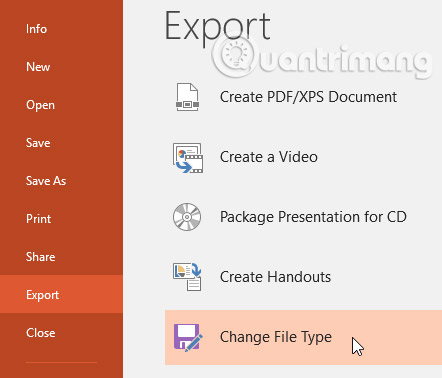
3. Select the file type, then click Save As.
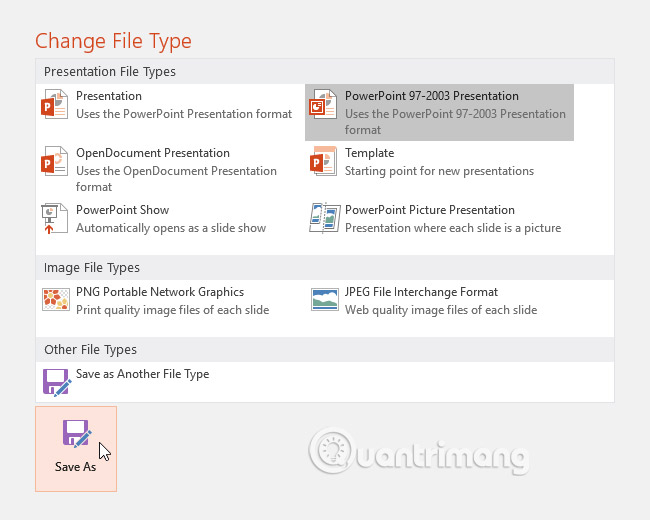
4. The Save As dialog box will appear. Select the location where you want to export the presentation, enter the file name, then click Save.
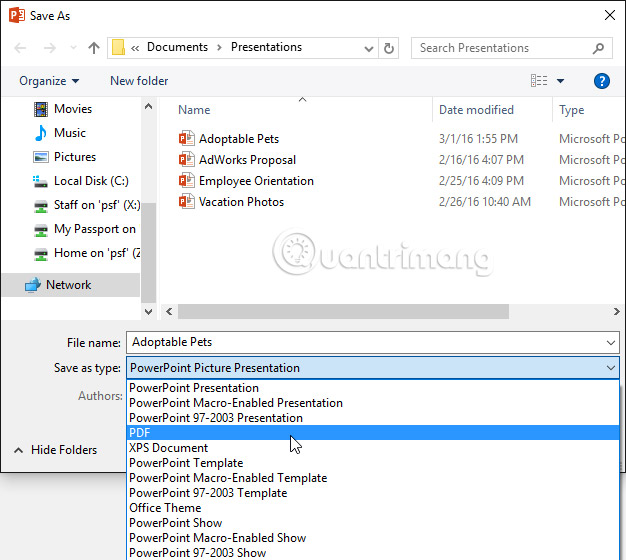
You can also use the Save As type drop-down menu in the Save As dialog box to save the presentation in a variety of file formats. Be careful in choosing the file type so that others can open it.
Share the presentation
PowerPoint makes it easy to share and collaborate on presentations with OneDrive. In the past, if you wanted to share files with someone, you could send the file as an email attachment. Although very convenient, this system also creates multiple versions of the same file, so it is difficult for users to organize and organize.
When you share a presentation from PowerPoint, you actually give others precise access to the same file. This allows you and the people you share to edit the presentation without having to track many different versions.
To share the presentation, it must first be saved to your OneDrive.
How to share the presentation
1. Click the File tab to access the Backstage view mode , then click Share.

2. Share control panel will appear.
3. Click on the interactive buttons below to learn more about how to share different presentations.
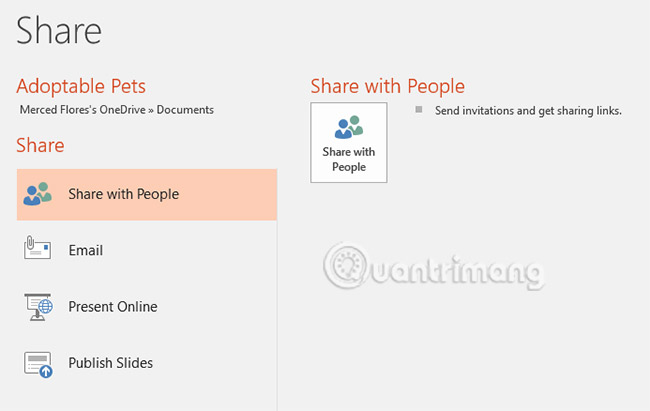
Practice!
1. Open the sample presentation.
2. Use Save As to create a copy of the presentation. Name the new copy of Saving Challenge Practice. You can save it to a folder on your computer or OneDrive.
3. Export the presentation as a PDF file.
See more:
- Start with PowerPoint 2016
- Create and open presentations in PowerPoint 2016
- How to create PowerPoint photo album with effects
You should read it
- Rehearsal and record presentations in PowerPoint 2016
- Check and protect presentations in PowerPoint 2016
- Save a slide presentation file in PowerPoint
- How to insert videos into PowerPoint 2016
- How to Convert Powerpoint to Jpeg
- Create impressive powerpoint endings for your presentation
- 10 useful tips for you when presenting with PowerPoint
- Presenting slide shows in PowerPoint 2016
May be interested
- Microsoft PowerPoint is about to have a feature to record presentations
 microsoft has just announced that it is about to add a new feature to its powerpoint presentation slide creation software. this new feature allows users to record (record) slide-based presentations in a simpler and more efficient way.
microsoft has just announced that it is about to add a new feature to its powerpoint presentation slide creation software. this new feature allows users to record (record) slide-based presentations in a simpler and more efficient way. - Share PowerPoint 2016 presentations online
 instead of displaying the slideshow as usual, you can choose to present it as a video or even online so that others can view it remotely.
instead of displaying the slideshow as usual, you can choose to present it as a video or even online so that others can view it remotely. - Summary of useful shortcuts in PowerPoint
 when you know and manipulate powerpoint with shortcuts, you will perform faster, slide shows easily compared to using manual manipulation.
when you know and manipulate powerpoint with shortcuts, you will perform faster, slide shows easily compared to using manual manipulation. - Fix 6 common errors on PowerPoint slides
 what could be worse when you are preparing to report in front of people and unexpectedly discover that your presentation slide is so prepared to show very unusual signs.
what could be worse when you are preparing to report in front of people and unexpectedly discover that your presentation slide is so prepared to show very unusual signs. - 5 websites and Powerpoint add-ins to find beautiful, free templates
 if you have not mastered powerpoint yet, you will need to consult from beautiful slideshow templates. the following free apps and websites will give you some templates to create beautiful presentations.
if you have not mastered powerpoint yet, you will need to consult from beautiful slideshow templates. the following free apps and websites will give you some templates to create beautiful presentations. - 10 awesome PowerPoint templates make the presentation 'shine'
 in today's article, tipsmake.com will introduce 10 best powerpoint templates, saving you time and effort when creating presentations.
in today's article, tipsmake.com will introduce 10 best powerpoint templates, saving you time and effort when creating presentations. - How to add subtitles and live translations to make your PowerPoint presentations better
 powerpoint for microsoft 365 makes it easier for people who are deaf or have language barriers to access your presentation. these features not only improve accessibility, but also make your presentations clearer and more inclusive for everyone.
powerpoint for microsoft 365 makes it easier for people who are deaf or have language barriers to access your presentation. these features not only improve accessibility, but also make your presentations clearer and more inclusive for everyone. - How to delete personal information from PowerPoint presentations before sharing
 office applications can store personal information in every file you create, meaning that all recipients of that file will have your information.
office applications can store personal information in every file you create, meaning that all recipients of that file will have your information. - Check and protect presentations in PowerPoint 2016
 before sharing a presentation, you always want to make sure it doesn't include any information that needs to be kept private. you may also discourage others from editing your file.
before sharing a presentation, you always want to make sure it doesn't include any information that needs to be kept private. you may also discourage others from editing your file. - How to cut photos using Microsoft PowerPoint
 powerpoint is a software used for presentations, it needs a design tool to create compelling presentations. therefore, you need to learn how to manipulate images and create interesting effects with photos in powerpoint. this article will show you three ways to edit photos in powerpoint.
powerpoint is a software used for presentations, it needs a design tool to create compelling presentations. therefore, you need to learn how to manipulate images and create interesting effects with photos in powerpoint. this article will show you three ways to edit photos in powerpoint.










 How to enter 0 in Google Sheets
How to enter 0 in Google Sheets How to delete table format in Excel
How to delete table format in Excel Usage of Min and Max functions in Excel
Usage of Min and Max functions in Excel Lesson 22: Working with the Text Box
Lesson 22: Working with the Text Box Lesson 23: Insert Clip Art
Lesson 23: Insert Clip Art Lesson 24: Working with Shapes
Lesson 24: Working with Shapes